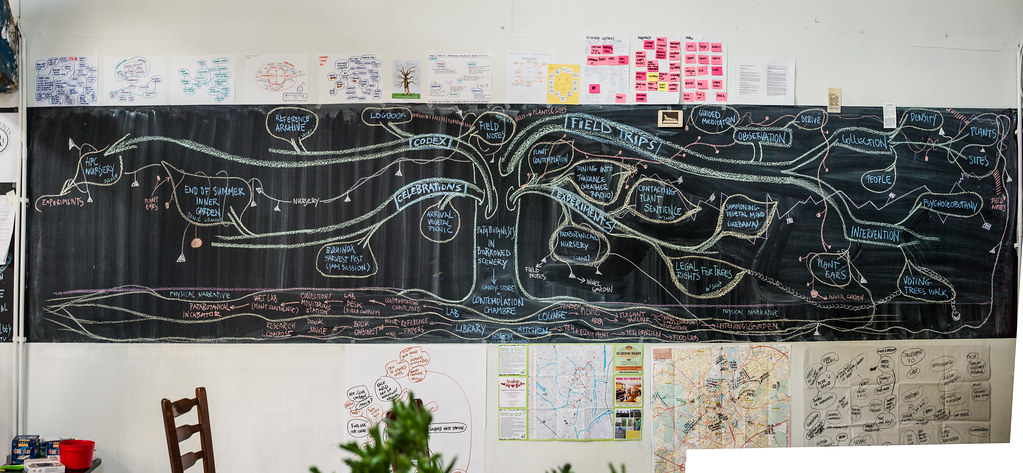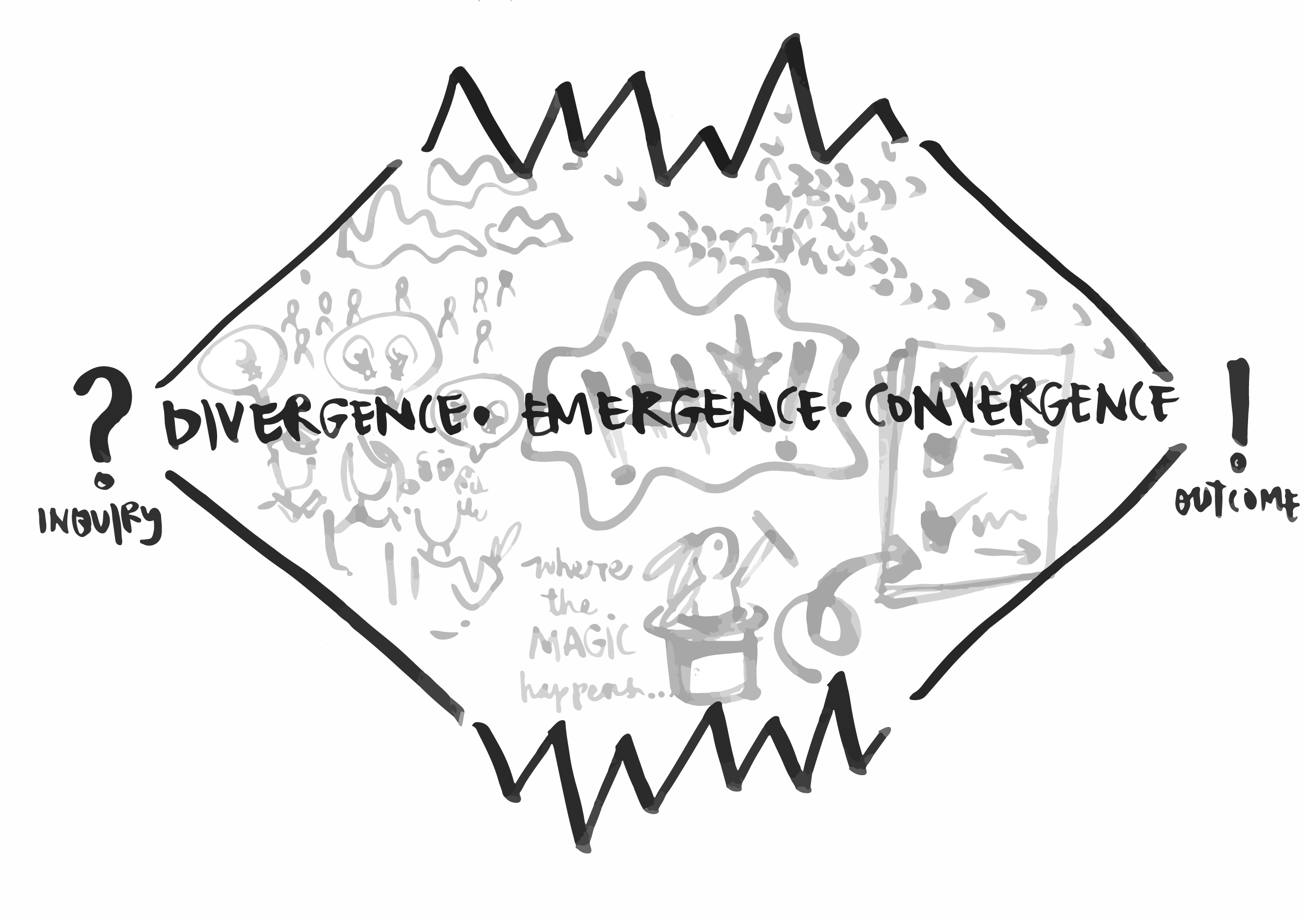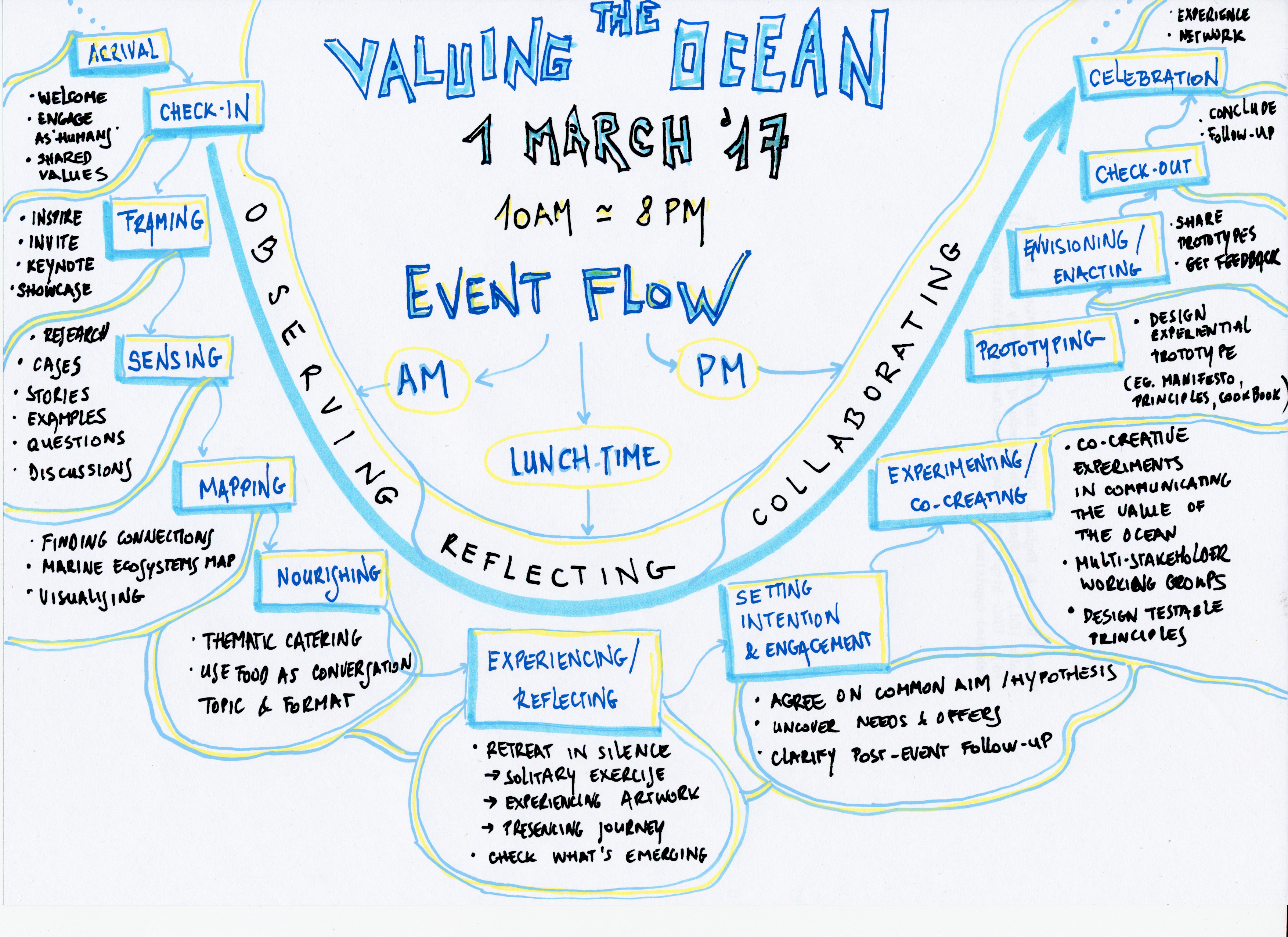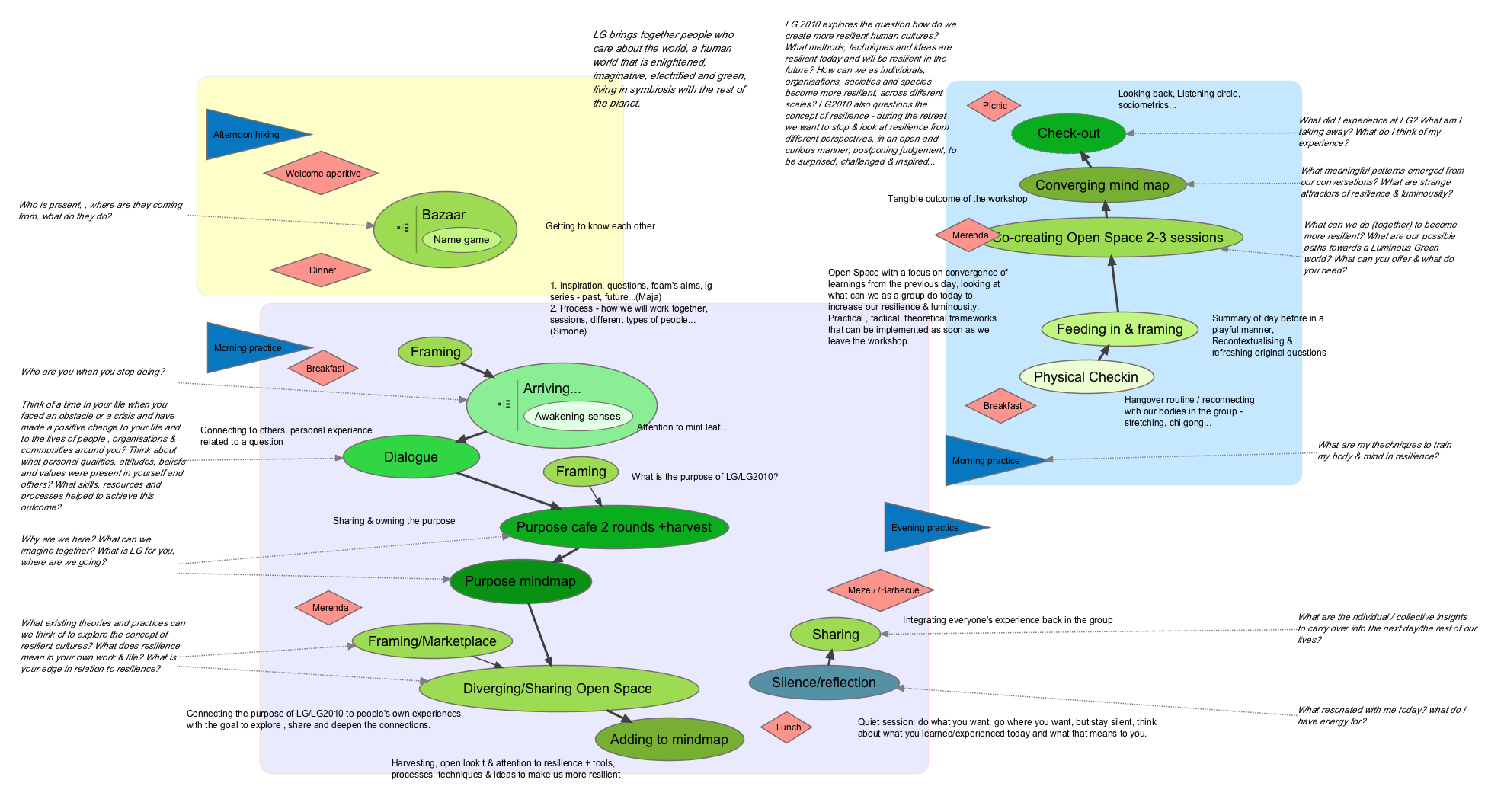Table of Contents
Event flow
What is the 'flow' of a participatory event? The flow provides an overview of the process as a whole and includes the connections and relationships between different elements (sessions, participants, spaces, content…). A good event flow assures that all the elements work together towards the desired outcome. Aside from the programme of an event (which is explicitly communicated to the participants), a flow also includes less tangible aspects, such as the rhythm of the setting and the changing atmosphere of the event.
Participatory experiences unfold both in time and in space. So when designing flows we have to consider both. With spatial flow we look at the physical and sensory aspects of an experience, e.g. different spaces and their design, and how the participants inhabit and the spaces and move between them. Temporal flow is about the sequence or progression of different elements of the process, such as the sessions, breaks, or social gatherings.
It helps to prepare the flow (in quite a bit of detail) beforehand, then adjust on the spot if something doesn’t feel right. Designing a flow is an iterative process. Start with a minimum that you know can work, then iterate. No predesigned flow is ever perfect. It’s like a canal vs. a river. A canal cuts through a landscape according to a plan, a river carves its way through a landscape on its lowest points, where there is least resistance. To recognise the resistance you'll have to rely on your observation and intuition: you watch carefully what's going on - not just the explicit communication, but also pay attention to body language, sounds, and other material and immaterial signs. You “hold space” for what emerges and adjust your flow accordingly.

Example: a meal
Let's look at an example of how flow works in a meal - a participatory experience we are probably all familiar with.
The “goal” of a meal could be seen as being fed (if possible with food we like eating). But the “purpose”, especially if we're eating with other people, might be very different - a family meal, a business lunch, a romantic dinner for two or a party with friends. Before designing a meal it is important to clarify the purpose, as this will impact how we go about designing it.
Imagine inviting some friends for a festive meal on a seasonal holiday. This week, for example some European cultures celebrate The Day of The Dead or All Hallow's eve. To align the meal to the mood of the festival, you might have a thematic meal - like “food for the spirits”, “ancestral cuisine” or a “seasonal pumpkin extravaganza”.
Then it's time to invite your friends to a shared thematic meal. Everyone is keen to come, but a few of them have peculiar food allergies – something to take into consideration.
So, once you've got the purpose, the theme and the guests, how do you go about designing the meal?
The food you prepare is of course the core of the meal. The food will consist of one or more recipes that take your guests dietary restrictions into account. In an event like CSAW, the core of the event will be the different sessions - e.g. lectures, discussions, hands-on workshops, social events… Each of the sessions will have its own content, methods and format - its own recipe. Yet before you get into the details of preparing each session you will also have to think about how the sessions can work together to contribute to the experience of the event as a whole. This is where flow design comes in.
Imagine getting ready to have a meal with one or more people you care about. You have prepared your favourite foods and drinks and everything is just as you'd like it to be.
- Who are you with? One person or a group? How do you welcome them to your meal?
- Where are you? What is the setting of your the meal? By a lake, in your room, or a dining room, or somewhere else…
- What is the atmosphere like? Bright and buzzing, intimate, subdued… Is there sound and if so, what kind of sound? How about lighting?
- What does the space smell like?
- How are people engaged in the space? On a picnic rug, at a table, walking around with your plate…
- What are the materials, textures you feel on the surfaces? How is the food presented? What implements do the guests use to eat with?
- Are there any other objects in the space? Furniture, artworks, books… How do they contribute to the atmosphere?
- What is on the menu?
- How will the guests experience the menu?
- Are there snacks or drinks to ease the guests into the meal?
- Does your meal have one or more courses? Is it a long tasting menu where one dish comes after another? Or a buffet? are there sharing plates, with everything laid out at the same time?
- Can the guests choose from different options or is everyone having the same experience at the same time?
Imagine how the meal unfolds.
- What do you taste? How do the tastes, smells and textures evolve over the course of the meal?
- Aside from eating, what else is going on? How are people interacting with each other?
- What is the rhythm of the meal? How long does it last?
- Do the guests still have room for dessert?
- How does the meal end?
- Do you ask the guests to help with cleaning up?
- How do the guests leave?
- How do you feel when it's all over?

Spatial Flow
Spatial Flow is about how people inhabit and move in the space, what is around them, what setting, atmosphere and physical elements can guide their experience.
A few things to consider:
Theme, purpose, vision, principles of the event
- How will the theme of the event be present in the physical aspects of the event?
- When you're sourcing materials, make sure you're aligned with the theme/purpose and principles of the event
Multiple senses
- What sensory and bodily experience are you trying to encourage?
- e.g. What does CSAW smell like? Feel like? Sound like? Etc.
- What can you convey about your theme and purpose through different spatial modalities, including the overall ambience?
Flow of physical movement
- The spatial flow has to consider how people move through the spaces, how long it will take to get from one session to another, will there be enough personal space, quiet zones, social zones, etc. It can help to create a map of all the indoor and outdoor spaces of the event, like a map of a role playing game.
Work with the site
- Make your design site-specific so you can build on the existing characteristics of the space. Also, if possible choose the venue that is aligned with your purpose and your values.
Be inclusive
- Consider how to use the atmosphere to make everyone feel included and at ease. Think about neurodiversity and people with different ranges of physical abilities.
Temporal flow
Temporal flow is about how to keep the participants engaged with the purpose of the event, from beginning to end.
There is no exact recipe how to design flows for participatory processes. There are specific methods, but they usually have to be adapted and customised for different circumstances. Remember that designing a flow isn’t only about methodologies and formats, but they can help when you're beginning.
Here are a few types of flow that humans experience in their daily life, which can be useful metaphors:
- ebb & flow of oceans
- breathing, pulsing
- birth, growth, decay, death
- daylight cycle - morning, afternoon, evening
- cycles within cycles - a flow is rarely linear progress (each session has its own flow, each day its own cycle…)
- bodily rhythms - different processes occurring simultaneously
Temporal flows in participatory processes often follow three interconnected phases:
- the first phase is about broadening the perspective, getting to a shared big picture
- the second phase is about grounding the group's knowledge in their lived experience, understanding their position in the big picture and coming up with ideas of how things could be otherwise.
- the third phase is about co-creating the ideas, making them concrete in some way, and deciding how to move forward.
The creative process
Most participatory processes are akin to the creative process which consists of phases of divergence and convergence, with an interesting, but usually difficult emergence zone in the middle, where most creative leaps happen, yet can also be confusing and uncomfortable - you know that something is going to change, but you are not sure what to do and how to do it. With CSAW co-creation, for example this happened when you had to choose one theme. Until then you were happily exploring different possibilities, but there came a moment when you suddenly had to converge on a theme. The discomfort that some of you experienced is a natural part of every creative process.
Rites of Passage

A similar flow is found in many rites of passage. The flow begins with separation of the 'passengers' from a previous state (e.g. childhood) and ends with the reincorporation of a new role (e.g. adulthood). Between these two distinct states is the 'liminal phase', where passengers begin to realise that what they previously considered 'normal' (i.e. what you were used to, comfortable with, or how you understood the world) no longer exists, but it's not obvious what a 'new normal' might be, or when it will emerge. In this phase there is no clear path forward and with new knowledge there is no way back. It could last a moment or become endless, as transitions unfold at different speeds and durations. This is a state that most of us in Europe find ourselves during the second wave of the pandemic (this blogpost compares the liminality of a rite of passage to the current situation).
U process
In “Theory U”, according to the Presencing Institute, the flow begins by moving down the left side of the U to connect to what exists in the wider world, then to the bottom of the U to connect to the world that emerges from within and up the right side of the U to bring forth something new into the world). In other words, the flow begins with observing, sensing and mapping the past and present context of the situation, then encourages reflection and visioning, and ends with co-creation for real life situations.
Here are a couple of examples of flow design for participatory events using the U process…
The Ocean Connects Us, one day event for marine organisations in the UK (https://fo.am/events/ocean-connects/)
Luminous Green, a retreat about resilience in a world that is enlightened, imaginative and electrified. https://fo.am/events/lg_2010/
Background
In psychology, according to Mihály Csíkszentmihályi, flow “is the mental state of operation in which a person performing an activity is fully immersed in a feeling of energized focus, full involvement, and enjoyment in the process of the activity. In essence, flow is characterized by complete absorption in what one does.”
According to the flow theory, three conditions have to be met in order to reach the state of flow (aka 'the zone'):
- involvement in an activity with clear goals and progress
- clear feedback must exist between your action and its effect on the task (so you can adjust what you’re doing to remain in the flow state)
- a good balance between perceived challenges and your own perceived skills - you must be confident that you are able to complete the task at hand.
When deliberately designing for flow experiences it’s good to keep these conditions and their effects in mind. It is therefore important to find out who the participants are, what is their skill level and what they’re interested in.
When designing for flow in groups, psychologists suggest that it is worth thinking about:
- Creative spatial arrangements: Chairs, pin walls, charts, but no tables; thus work primarily standing and moving
- Playground design: Charts for information inputs, flow graphs, project summary, craziness (here also craziness has a place), safe place (here all may say what is otherwise only thought), result wall, open topics
- Parallel, organized working
- Target group focus
- Prototyping and visualising, making ideas concrete
- Using differences among participants as an opportunity, rather than an obstacle
In ecology flow is about the flow of energy in self-organising systems, a way of maintaining a dynamic balance. For example, we talk about energy flows in the food chain: solar energy fixed by plants, moving to primary consumers, herbivores who eat the plants, then to secondary consumers, carnivores and predators who eat the herbivores and finally the decomposers the fungi, maggots and insects who eat all that decays.
In permaculture it is important to harness the natural flows of energies as water, traffic and wildlife. Flow is the dynamic and changeable aspect of permaculture design. Another aspect of flow in permaculture is the flow of energy conservation, where a self-sustaining system divides its energy into three phases. 1/3 energy used to preserve yourself, 1/3 energy you give to smaller components that can feed you and finally 1/3 of your energy goes to maintaining the larger system on which you are dependent. Crowd dynamics
Behaviour of crowds is modelled using fluid dynamics, which studies the physical aspects of liquids. Crowd dynamics is used in urban planning, architecture, disaster drills, risk and crowd control (protests, manifestations). Crowds are a flowing continuum (a term from borrowed from fluid mechanics). In fluid mechanics equations applicable to thinking fluids can for example be used to assist crowd control to prevent deaths due to aggressive mob dynamics, for example in the muslim hajj, traffic jams, battles, evacuation, etc.
Flow loop model is another way to approach participatory flows, that borrows from game design where it's important to find meaningful challenges and get clear feedback about progress on those challenges.
The flow spirals through different cycles of opportunity for action → action → performance feedback → opportunity for action → action → …
In this model several conditions must be met:
- Knowing what to do
- Knowing how to do it
- Knowing how well you are doing
- Knowing where to go (if navigation is involved)
- High perceived challenges
- High perceived skills
- Freedom from distractions
Read more about the flow loop model [pdf]



